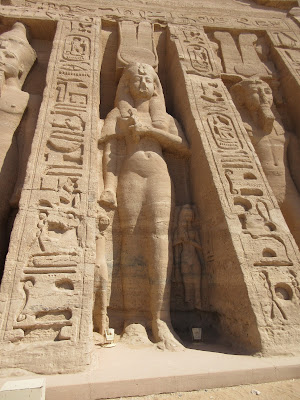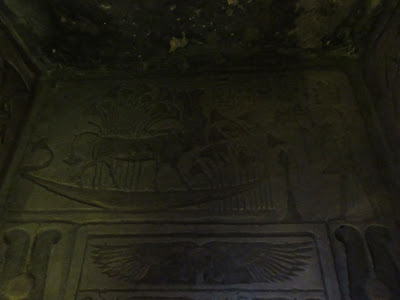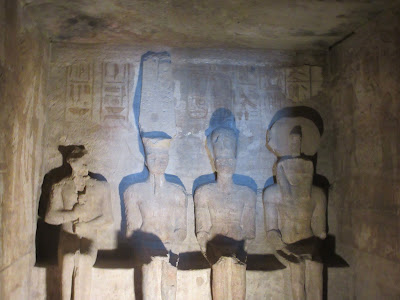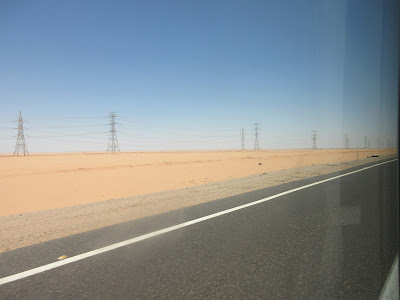All this early rising has some reason. Not only beating the crowds and enjoying our visits in the cool of early morning, but also slowly getting ready for the very early wake up call on the day than we visit Abu Simbel. The journey is four hours by bus from Aswan, so we need to get up in the middle of the night (3AM) so that around 4AM we are already on our way.

As we could not have breakfast in the boat, we are given a packed breakfast box each, to eat on the way. It looks like the box you would pack a cake in. We shall see later what it contains.
The journey starts with a terrible traffic gridlock before even leaving Aswan. The traffic police have organised some sort of pointless checkpoint at the main road in the direction of Abu Simbel.
The journey takes four hours each way. We spend the time taking pictures, chatting, but mostly sleeping. I personally have downloaded several science and history podcasts as well as the audiobook "Imprisoned with the Pharaohs" by H.P. Lovecraft, but also spend most of the time drifting in and out of slumber.

At some point, we do a 'pit stop' for a coffee and a leak break. After that, back on the road, we proceed to 'unboxing' out packed breakfasts. The box contains water, fruit juice, lots of small sandwiches, pastries, fruit and even a small pack with a few olives and a piece of cucumber.

As we get closer to Abu Simbel, other traveler transports show up in front of us on the road. Finally, traffic signs tell us we are arriving to Abu Simbel.
Abu Simbel used to lie at the border with Nubia, past the first cataract. It comprises two temples, buit by Ramses II and dedicated to Nefertari and Hathor the small one and Ptah, Amon, Ra and Ramses himself as another god the larger one.
When the new dam that created the Nasser lake was to be built, in the 1950's, UNESCO arranged an international project so that several temples were moved out of the future lake. Between 1964 and 1968 a total of 16 temples were moved, four of then given to the countries that contributed most in this endeavour. Abu Simbel was cut into blocks and moved 180m back and 65m up into an artificial mound purposely built to host these two temples.

The temples in this complex are swarming with tourists. The heat and the (sweaty) moisture fill their interiors. When in places like this, I cannot help but remember the old computer game Lemmings.

Nefertari's Hathor temple is fronted with six large statues, of which four are of Ramses II. He was generous enough to erect the remaining two in the image of his beloved wife, Nefartari. Inside the temple, Ramses II's propaganda still abound. From the classic image of the killing of enemies to a curious (possibly unique) image in which both Seth and Horus are endowing Ramses II with the kingship. the temple is still dedicated to Hathor, with hathoric pillars and images of the goddess both as human and cow. Images dedicated to Nefertari also abound, of great beauty.

Ramses II's temple is larger and more impressive. Fronted with four huge statues of Ramses (of which one already broke in antiquity). Its entrance is flanqued by all the names of Ramses II and the lines of captive enemies. Asiatics on one side, Nubians on the other.
Inside, more statues of Ramses, his names everywhere, the smiting of enemies, different peoples bringing tributes to the king while Amun is watching, and finally, the sancta sanctorum. Four statues, of the main gods of Egypt... and Ramses II. Ptah, Amun, Re, and Ramses II, siting side by side as equals.
This chamber has the characteristic that it is oriented thus that twice a year, the sun would shine through the length of the temple and illuminate three of the statues (not Ptah, which traditionaly is kept in the dark). It used to happen on 21st of February and 21st of October, on the Innundation Festival and the Harvest Festival. With the translation of the temples, the alignent was not perfect and it occurs one day late.

The trip back has been again between wakefullness and asleep, with the empty landscape punctuated with surprising images, like a factory in the middle of the desert, or several dozen tanks parked a few hundred metres from the road. And talking of those tanks, what sense does it make that a country that is mostly desert have tanks painted in jungle camouflage?
























No comments:
Post a Comment